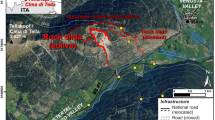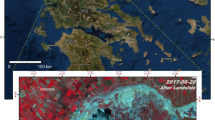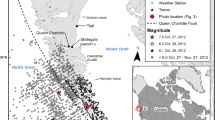Abstract
The recent San Eduardo Landslide (SEL), reactivated on the nighttime of September 20, 2018, is hypothesized as the lowest part of a large-scale deep-seated gravitational slope deformation (DSGSD) covering an area not less than 45 km2. Based upon remote sensing analysis through aerial photography, accompanied by fieldwork, this work attempts to identify the morphostructural features developed after reactivation of the SEL, as well as relict features upslope indicating active sagging of the adjacent mountain slopes. A preliminary segmentation of the SEL into three zones (SEL-1 to SEL-3) is proposed in order to describe the spatial distribution of extensional (e.g., uphill-facing scarps, trenches), compressional (toe bulging), and shear zones within the slid mass. To complement the geomorphological approach, displacement vectors and motion rates were derived by comparing a 5-month time series of free-cloud Sentinel 2 imagery acquired from September 2018 to February 2019. This approach helps to identify a peak motion rate of > 4 m/day in zones SEL-2 (between September 18 and 28, 2018) and SEL-3 (between September 8, 2018, and October 8, 2018). By February 2019, the motion rate decreased to less than 30 cm/day. The potential mechanisms explaining the triggering/reactivation of the large slope deformation observed are the cumulative displacement on a shale-dominated slope, and the high topographic stresses expected for this high-relief area in the Colombian Eastern Cordillera. Finally, this work explores the geomorphological evidence of a second DSGSD (sackung type) in the area, which in turn suggests that gravitational deformation is probably a more common deformation mechanism in the range than previously considered.












Similar content being viewed by others
References
Agliardi F, Crosta G, Zanchi A (2001) Structural constraints on deep-seated slope deformation kinematics. Eng Geol 59:83–102
Agliardi F, Zanchi A, Crosta GB (2009) Tectonic vs. gravitational morphostructures in the central Eastern Alps (Italy): constraints on the recent evolution of the mountain range. Tectonophysics 474:250–270. https://doi.org/10.1016/j.tecto.2009.02.019
Agliardi F, Crosta GB, Frattini P (2016) Slow rock-slope deformation. In: Clague JJ, Stead D (eds) Landslides. Cambridge University Press, Cambridge, pp 207–221
Ambrosi C, Crosta GB (2006) Large sackung along major tectonic features in the central Italian Alps. Eng Geol 83:183–200. https://doi.org/10.1016/j.enggeo.2005.06.031
Ambrosi C, Crosta GB (2011) Valley shape influence on deformation mechanisms of rock slopes. Geol Soc London, Spec Publ 351:215–233. https://doi.org/10.1144/sp351.12
Apuani T, Masetti M, Rossi M (2007) Stress – strain – time numerical modelling of a deep-seated gravitational slope deformation : preliminary results. Quat Int 172:80–89. https://doi.org/10.1016/j.quaint.2007.01.014
Audemard FA, Beck C, Carrillo E (2010) Deep-seated gravitational slope deformations along the active Boconó Fault in the central portion of the Mérida Andes, western Venezuela. Geomorphology 124:164–177. https://doi.org/10.1016/j.geomorph.2010.04.020
Aydin A (2009) ISRM suggested method for determination of the Schmidt hammer rebound hardness: revised version. Int J Rock Mech Min Sci 46(3):627–634. https://doi.org/10.1016/j.ijrmms.2008.01.020
Aydin A, Basu A (2004) The Schmidt hammer in rock material characterization. Eng Geol 81:1–14
Azañón JM, Azor A, Pérez-Peña JV, Carrillo JM (2005) Late Quaternary large-scale rotational slides induced by river incision: the Arroyo de Gor area (Guadix basin, SE Spain). Geomorphology 69:152–168. https://doi.org/10.1016/j.geomorph.2004.12.007
Bachmann D, Bouissou S, Chemenda A (2006) Influence of large scale topography on gravitational rock mass movements: new insights from physical modeling. Geophys Res Lett 33. https://doi.org/10.1029/2006GL028028
Bachmann D, Bouissou S, Chemenda A (2010) Influence of weathering and pre-existing large scale fractures on gravitational slope failure: insights from 3-D physical modelling. Nat Hazards Earth Syst Sci 4:711–717. https://doi.org/10.5194/nhess-4-711-2004
Bayona G, Cortés M, Jaramillo C et al (2008) An integrated analysis of an orogen- sedimentary basin pair: latest Cretaceous-Cenozoic evolution of the linked Eastern Cordillera orogen and the Llanos foreland basin of Colombia. Bull Geol Soc Am 120:1171–1197. https://doi.org/10.1130/B26187.1
Bisci C, Burattini F, Dramis F et al (1996) The Sant’Agata Feltria landslide (Marche Region, central Italy): a case of recurrent earthflow evolving from a deep-seated gravitational slope deformation. Geomorphology 15:351–361. https://doi.org/10.1016/0169-555X(95)00080-O
Bonzanigo L, Eberhardt E, Loew S (2007) Long-term investigation of a deep-seated creeping landslide in crystalline rock. Part I. geological and hydromechanical factors controlling the Campo Vallemaggia landslide. Can Geotech J 44:1157–1180. https://doi.org/10.1139/T07-043
Bookhagen B, Strecker MR (2008) Orographic barriers, high-resolution TRMM rainfall, and relief variations along the eastern Andes. Geophys Res Lett 35:1–6. https://doi.org/10.1029/2007GL032011
Bovis MJ, Evans SG (1996) Extensive deformations of rock slopes in southern Coast Mountains, southwest British Columbia, Canada. Eng Geol 44:163–182. https://doi.org/10.1016/s0013-7952(96)00068-3
Brückl E, Parotidis M (2005) Prediction of slope instabilities due to deep-seated gravitational creep. Nat Hazards Earth Syst Sci 5:155–172
Brückl E, Brunner FK, Lang E et al (2013) The Gradenbach Observatory — monitoring deep-seated gravitational slope deformation by geodetic , hydrological , and seismological methods. Landslides 10:815–829. https://doi.org/10.1007/s10346-013-0417-1
Carlà T, Tofani V, Lombardi L et al (2019) Combination of GNSS, satellite InSAR, and GBInSAR remote sensing monitoring to improve the understanding of a large landslide in high alpine environment. Geomorphology 335:62–75. https://doi.org/10.1016/j.geomorph.2019.03.014
Chigira M (1992) Long-term gravitational deformation of rocks by mass rock creep. Eng Geol 32:157–184. https://doi.org/10.1016/0013-7952(92)90043-X
Chigira M (2009) September 2005 rain-induced catastrophic rockslides on slopes affected by deep-seated gravitational deformations, Kyushu, southern Japan. Eng Geol 108:1–15. https://doi.org/10.1016/j.enggeo.2009.03.005
Chigira M, Hariyama T, Yamasaki S (2013) Development of deep-seated gravitational slope deformation on a shale dip-slope: observations from high-quality drill cores. Tectonophysics 605:104–113. https://doi.org/10.1016/j.tecto.2013.04.019
Christie-Blick N, Biddle KT (1985) Deformation and basin formation along strike-slip faults. In: Christie-Blick N, Biddle KT (eds) Strike-slip deformation, basin formation, and sedimentation, Special Pu. Society of Economic Paleontologist and Mineralogist, pp 1–34
Cortés M, Angelier J (2005) Current states of stress in the northern Andes as indicated by focal mechanisms of earthquakes. Tectonophysics 403:29–58. https://doi.org/10.1016/j.tecto.2005.03.020
Crosta GB, Frattini P, Agliardi F (2013) Deep seated gravitational slope deformations in the European Alps. Tectonophysics 605:13–33. https://doi.org/10.1016/j.tecto.2013.04.028
Dimate C, Rivera L, Taboada A et al (2003) The 19 January 1995 Tauramena (Colombia) earthquake: geometry and stress regime. Tectonophysics 363:159–180. https://doi.org/10.1016/S0040-1951(02)00670-4
Dramis F, Sorriso-Valvo M (1994) Deep-seated gravitational slope deformations, related landslides and tectonics. Eng Geol 38:231–243. https://doi.org/10.1016/0013-7952(94)90040-X
Dramis F, Farabollini P, Gentili B, Pambianchi G (1994) Neotectonics and large-scale gravitational phenomena in the Umbria-Marche Apennines, Italy. In: Comerci V, D’Agostino N, Fubelli G, et al. (eds) Seismically induced ground ruptures and large scale mass movements. pp 17–34
El Bedoui S, Guglielmi Y, Lebourg T, Pérez J (2009) Geomorphology deep-seated failure propagation in a fractured rock slope over 10,000 years : The La Clapière slope , the south-eastern French Alps. Geomorphology 105:232–238. https://doi.org/10.1016/j.geomorph.2008.09.025
Fleming RW, Johnson AM (1989) Structures associated with strike-slip faults that bound landslide elements. Eng Geol 27:39–114. https://doi.org/10.1016/0013-7952(89)90031-8
Gutiérrez F, Ortuño M, Lucha P et al (2008) Late Quaternary episodic displacement on a sackung scarp in the central Spanish Pyrenees. Secondary paleoseismic evidence? Geodin Acta 21:187–202. https://doi.org/10.3166/ga.21.187-202
Gutiérrez-Santolalla F, Acosta E, Ríos S et al (2005) Geomorphology and geochronology of sackung features (uphill-facing scarps) in the central Spanish Pyrenees. Geomorphology 69:298–314. https://doi.org/10.1016/j.geomorph.2005.01.012
Hart MW, Shaller PJ, Farrand GT (2012) When landslides are misinterpreted as faults: case studies from the western United States. Environ Eng Geosci 18:313–325. https://doi.org/10.2113/gseegeosci.18.4.313
Hippolyte JC, Brocard G, Tardy M et al (2006) The recent fault scarps of the Western Alps (France): tectonic surface ruptures or gravitational sackung scarps? A combined mapping, geomorphic, levelling, and 10Be dating approach. Tectonophysics 418:255–276. https://doi.org/10.1016/j.tecto.2006.02.009
Hou Y, Chigira M, Tsou C-Y (2014) Numerical study on deep-seated gravitational slope deformation in a shale-dominated dip slope due to river incision. Eng Geol 179:59–75. https://doi.org/10.1016/j.enggeo.2014.06.020
Hradecký J, Pánek T (2008) Deep-seated gravitational slope deformations and their influence on consequent mass movements (case studies from the highest part of the Czech Carpathians). Nat Hazards 45:235–253. https://doi.org/10.1007/s11069-007-9157-7
Hungr O, Dušek R, Hradecký J et al (2008) Late Holocene catastrophic slope collapse affected by deep-seated gravitational deformation in flysch: Ropice Mountain, Czech Republic. Geomorphology 103:414–429. https://doi.org/10.1016/j.geomorph.2008.07.012
Jaboyedoff M, Crosta GB, Stead D (2011) Slope tectonics: a short introduction. Geol Soc London, Spec Publ 351:1–10. https://doi.org/10.1144/sp351.1
Jaboyedoff M, Penna I, Pedrazzini A et al (2013) An introductory review on gravitational-deformation induced structures, fabrics and modeling. Tectonophysics 605:1–12. https://doi.org/10.1016/j.tecto.2013.06.027
Jomard H, Lebourg T, Tric E (2007) Identification of the gravitational boundary in weathered gneiss by geophysical survey: La Clapière landslide (France). J Appl Geophys 62:47–57. https://doi.org/10.1016/j.jappgeo.2006.07.003
Julivert M (1961) El papel de la gravedad y la erosión en las estructuras del borde oriental de la Sabana de Bogotá. Bol Geol 8:5–20
Kinakin D, Stead D (2005) Analysis of the distributions of stress in natural ridge forms: implications for the deformation mechanisms of rock slopes and the formation of sackung. Geomorphology 65:85–100. https://doi.org/10.1016/j.geomorph.2004.08.002
Kromuszczyńska O, Mège D, Dębniak K, et al (2018) Deep-seated gravitational slope deformation scaling on Mars and Earth: same fate for different initial conditions and structural evolutions. Earth Surf Dyn Discuss 1–22. https://doi.org/10.5194/esurf-2018-27
Lacroix P, Bièvre G, Pathier E et al (2018) Use of Sentinel-2 images for the detection of precursory motions before landslide failures. Remote Sens Environ 215:507–516. https://doi.org/10.1016/j.rse.2018.03.042
Lebourg T, Binet S, Tric E et al (2005) Geophysical survey to estimate the 3D sliding surface and the 4D evolution of the water pressure on part of a deep seated landslide. Terra Nov 17:399–406. https://doi.org/10.1111/j.1365-3121.2005.00623.x
Lin HH, Lin ML, Lu JH et al (2020) Deep-seated gravitational slope deformation in Lushan, Taiwan: transformation from cleavage-controlled to weakened rockmass-controlled deformation. Eng Geol 264:105387. https://doi.org/10.1016/j.enggeo.2019.105387
McCalpin JP (1999) Criteria for determinating the seismic significance of Sackungen and other scarplike landforms in mountain regions. In: Techniques for identifying faults and determining their origin. U.S. Nuclear Regulatory Commission, pp 2.55–2.59
McCalpin JP, Corominas J (2019) Postglacial deformation history of sackungen on the northern slope of Pic d’Encampadana, Andorra. Geomorphology 337:134–150. https://doi.org/10.1016/j.geomorph.2019.04.007
McCalpin JP, Bruhn RL, Pavlis TL et al (2011) Antislope scarps, gravitational spreading, and tectonic faulting in the western Yakutat microplate, south coastal Alaska. Geosphere 7:1143–1158. https://doi.org/10.1130/GES00594.1
Montero J (2017) Clasificación de movimientos en masa y su distribución en terrenos geológicos de Colombia. Publicaciones Geológicas Especiales. Servicio Geológico Colombiano, pp 190
Mora A, Parra M, Strecker MR et al (2008) Climatic forcing of asymmetric orogenic evolution in the Eastern Cordillera of Colombia. Bull Geol Soc Am 120:930–949. https://doi.org/10.1130/B26186.1
Mora A, Gaona T, Kley J et al (2009) The role of inherited extensional fault segmentation and linkage in contractional orogenesis: a reconstruction of lower cretaceous inverted rift basins in the Eastern Cordillera of Colombia. Basin Res 21:111–137. https://doi.org/10.1111/j.1365-2117.2008.00367.x
Mora A, Parra M, Strecker MR et al (2010) The eastern foothills of the eastern cordillera of Colombia: an example of multiple factors controlling structural styles and active tectonics. Bull Geol Soc Am 122:1846–1864. https://doi.org/10.1130/B30033.1
Moro M, Saroli M, Salvi S et al (2007) The relationship between seismic deformation and deep-seated gravitational movements during the 1997 Umbria-Marche (Central Italy) earthquakes. Geomorphology 89:297–307. https://doi.org/10.1016/j.geomorph.2006.12.013
Moro M, Saroli M, Gori S et al (2012) The interaction between active normal faulting and large scale gravitational mass movements revealed by paleoseismological techniques: a case study from Central Italy. Geomorphology 151–152:164–174. https://doi.org/10.1016/j.geomorph.2012.01.026
Page WD, Mattsson L (1981) Landslide lakes near Santa Fé de Antioquia. Rev CIAF 6:469–478
Pánek T, Klimeš J (2016) Temporal behavior of deep-seated gravitational slope deformations: a review. Earth-Sci Rev 156:14–38. https://doi.org/10.1016/j.earscirev.2016.02.007
Pánek T, Tábořík P, Klimeš J et al (2011) Deep-seated gravitational slope deformations in the highest parts of the Czech Flysch Carpathians: evolutionary model based on kinematic analysis, electrical imaging and trenching. Geomorphology 129:92–112. https://doi.org/10.1016/j.geomorph.2011.01.016
Pánek T, Smolková V, Hradecký J et al (2013) Holocene reactivations of catastrophic complex flow-like landslides in the Flysch Carpathians (Czech Republic/Slovakia). Quat Res 80:33–46. https://doi.org/10.1016/j.yqres.2013.03.009
Parra M, Mora A, Sobel ER, et al (2009) Episodic orogenic front migration in the northern Andes: constraints from low-temperature thermochronology in the Eastern Cordillera, Colombia Tectonics 28. https://doi.org/10.1029/2008TC002423
Pedrazzini A, Humair F, Jaboyedoff M, Tonini M (2016) Characterisation and spatial distribution of gravitational slope deformation in the Upper Rhone catchment (Western Swiss Alps). Landslides 13:259–277. https://doi.org/10.1007/s10346-015-0562-9
Pérez R, Castro J, García-Delgado H, Chaparro J et al (2019) Zonificación de amenaza por movimientos en masa en el municipio de San Eduardo – Boyacá. Escala 1:25,000. Servicio Geológico Colombiano Internal Report, Bogotá (In Spanish)
Pisani G, Castelli M, Scavia C (2010) Hydrogeological model and hydraulic behaviour of a large landslide in the Italian Western Alps. Nat Hazards Earth Syst Sci 10:2391–2406. https://doi.org/10.5194/nhess-10-2391-2010
Ramirez-Arias JC, Mora A, Rubiano J et al (2012) The asymmetric evolution of the Colombian Eastern Cordillera. Tectonic inheritance or climatic forcing? New evidence from thermochronology and sedimentology. J S Am Earth Sci 39:112–137. https://doi.org/10.1016/j.jsames.2012.04.008
Reyes I (1983) Tectónica gravitacional en la Cordillera Oriental al este de la Falla de Boyacá (Departamento de Boyacá). Bol Geol 16:103–117
Sacchini A, Faccini F, Ferraris F et al (2016) Large-scale landslide and deep-seated gravitational slope deformation of the Upper Scrivia Valley (northern Apennine, Italy). J Maps 12:344–358. https://doi.org/10.1080/17445647.2015.1021393
Struth L, Babault J, Teixell A (2015) Drainage reorganization during mountain building in the river system of the Eastern Cordillera of the Colombian Andes. Geomorphology 250:370–383. https://doi.org/10.1016/j.geomorph.2015.09.012
Struth L, Teixell A, Owen LA, Babault J (2017) Plateau reduction by drainage divide migration in the Eastern Cordillera of Colombia defined by morphometry and10Be terrestrial cosmogenic nuclides. Earth Surf Process Landf 42:1155–1170. https://doi.org/10.1002/esp.4079
Terraza R, Moreno G, Buitrago J et al (2010) Geología de la plancha 210 - Guateque. Serv Geol Colombiano 146:6
Tolomei C, Taramelli A, Moro M et al (2013) Analysis of the deep-seated gravitational slope deformations over Mt. Frascare (Central Italy) with geomorphological assessment and DInSAR approaches. Geomorphology 201:281–292. https://doi.org/10.1016/j.geomorph.2013.07.002
Tsou CY, Chigira M, Matsushi Y, Chen SC (2015) Deep-seated gravitational deformation of mountain slopes caused by river incision in the central range. Spatial distribution and geological characteristics. Elsevier B.V, Taiwan
Varnes D, Coe J, Godt J, et al (2000) Measurement of ridge-spreading movements (sackungen) at Bald Eagle Mountain, Lake County, Colorado, II: continuation of the 1975-1989 measurements using a global positioning system in 1997 and 1999
Vilímek V, Zvelebil J, Klimeš J et al (2007) Geomorphological research of large-scale slope instability at Machu Picchu, Peru. Geomorphology 89:241–257. https://doi.org/10.1016/j.geomorph.2006.12.004
Willett S (1999) Orogeny and orography: the effects of erosion on the structure of mountain belts. J Geophys Res Earth Surf 104:28957–28981. https://doi.org/10.1029/1999JB900248
Zangerl C, Eberhardt E, Perzlmaier S (2010) Kinematic behaviour and velocity characteristics of a complex deep-seated crystalline rockslide system in relation to its interaction with a dam reservoir. Eng Geol 112:53–67. https://doi.org/10.1016/j.enggeo.2010.01.001
Acknowledgments
The author wants to thank the Colombian Geological Survey for the economic assistantship that supported the field trip to the San Eduardo municipality. This field trip was carried out in the framework of Project 1000637—Mass Movement Hazard Assessment of San Eduardo at a 1:25,000 scale. The author also thanks Andrés Reyes for downloading and sharing the precipitation data. Both the Editorial Board and an anonymous reviewer are thanked for their comments.
Author information
Authors and Affiliations
Corresponding author
Rights and permissions
About this article
Cite this article
García-Delgado, H. The San Eduardo Landslide (Eastern Cordillera of Colombia): Reactivation of a deep-seated gravitational slope deformation. Landslides 17, 1951–1964 (2020). https://doi.org/10.1007/s10346-020-01403-9
Received:
Accepted:
Published:
Issue Date:
DOI: https://doi.org/10.1007/s10346-020-01403-9




